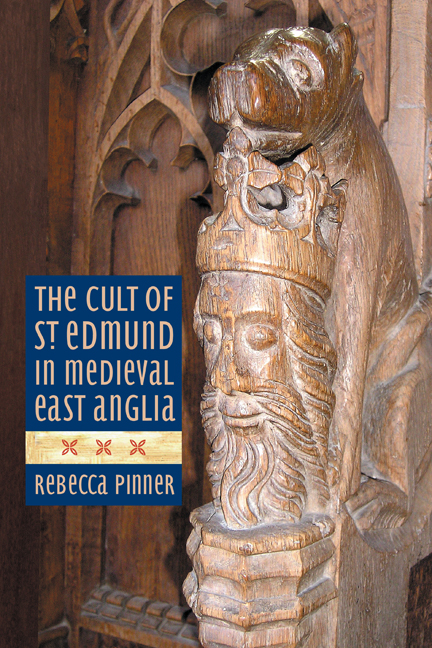Book contents
- Frontmatter
- Contents
- List of Illustrations
- Acknowledgements
- Abbreviations
- Introduction
- Part I Texts and Contexts: the Legend of St Edmund
- Part II Relics, Shrines and Pilgrimage: Encountering St Edmund at Bury
- Part III Beyond Bury: Dissemination and Appropriation
- Conclusion: ‘Martir, Mayde and Kynge’, and More
- Appendix 1 Synoptic Account of the Legend of St Edmund
- Appendix 2 Chronology of Significant Events and Texts Associated with the Cult of St Edmund
- Bibliography
- Index
Chapter 1 - The Emergence of the Hagiographic Tradition: Abbo of Fleury, Passio Sancti Eadmundi
Published online by Cambridge University Press: 21 May 2021
- Frontmatter
- Contents
- List of Illustrations
- Acknowledgements
- Abbreviations
- Introduction
- Part I Texts and Contexts: the Legend of St Edmund
- Part II Relics, Shrines and Pilgrimage: Encountering St Edmund at Bury
- Part III Beyond Bury: Dissemination and Appropriation
- Conclusion: ‘Martir, Mayde and Kynge’, and More
- Appendix 1 Synoptic Account of the Legend of St Edmund
- Appendix 2 Chronology of Significant Events and Texts Associated with the Cult of St Edmund
- Bibliography
- Index
Summary
‘On such occasions each would contribute to the others such information as he himself had obtained; and thereupon one would afterwards confer with another. I, too, used to furnish a few particulars which I had gained by word of mouth from others, or learned from reading aloud.’
The hagiographic tradition
IN contrast to the largely static chronicle tradition, the hagiographic representation of Edmund was constantly evolving, with each author seeking to add to the repository of knowledge concerning Edmund's life, death and posthumous deeds. Many hagiographers make frequent intertextual references, and whilst referring to previous versions of the legends bolsters their own authorial credibility, it also indicates that they are aware of contributing to a continuous, evolving narrative. The hagiographic tradition appears to develop independently of its annular counterpart, as from the outset it offers a different version of events: whereas in the brief chronicle entries Edmund meets his death in battle, the hagiographers develop the narrative of martyrdom, where Edmund is captured by the Danes and dies in defence of his faith. The prototype for the chronicle tradition is an authoritative ‘historical’ work, the Anglo-Saxon Chronicle, but the hagiographers appear to lack a similar documentary precedent, which supports the assertion that Edmund's cult is almost entirely constructed. It also raises the question of how the alternative hagiographic versions originate and how they are authorised in ways which allow them to deviate from a source as respected and established as the Anglo-Saxon Chronicle.
A useful corollary is to be found in Winstead's discussion of the lives of female virgin martyrs. The early lives emphasise sensation and confrontation, whereas by the thirteenth century a more explicitly didactic mode of representation was dominant, including lavish prayers and passages of exposition. Writers of the late fourteenth century distanced the saints from the increasingly prominent laity by emphasising their miraculous abilities and their contempt for institutions such as family and state. In contrast, most likely in response to fear of Lollardy and misdirected lay learning, the female virgin martyrs of the fifteenth century were significantly less radical and confrontational and more conservative. It is particularly noteworthy that Winstead identifies Lydgate's Lives of the female virgin martyrs Sts Margaret and Petronilla as conforming to these later medieval developments, as this allows direct comparison with his presentation of Edmund.
- Type
- Chapter
- Information
- The Cult of St Edmund in Medieval East Anglia , pp. 33 - 47Publisher: Boydell & BrewerPrint publication year: 2015



